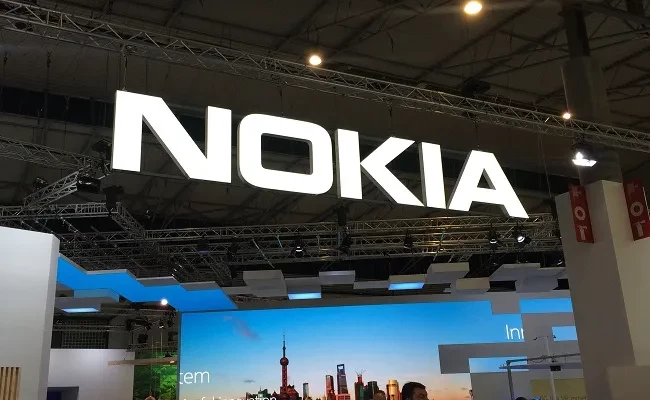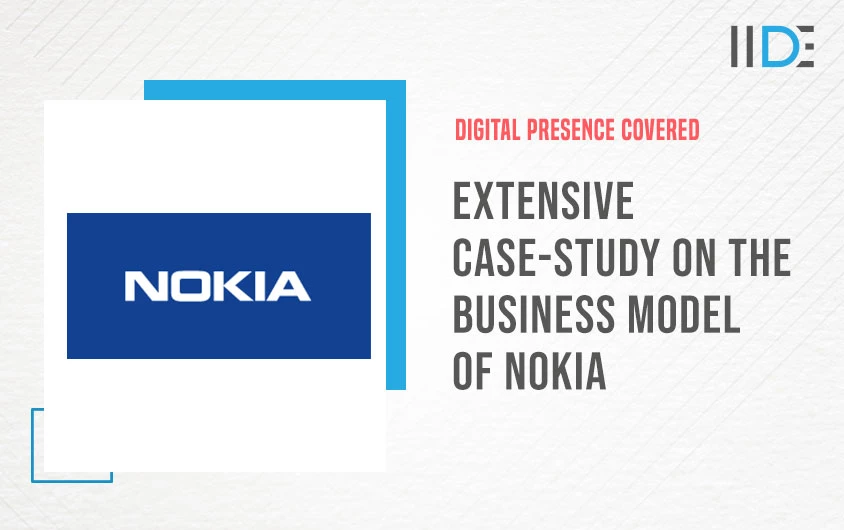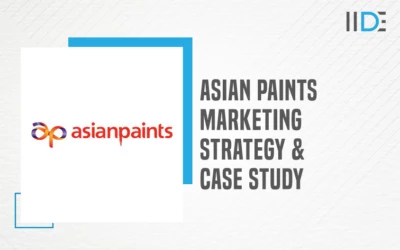According to the stats Nokia the multinational company itself was the best cell phone developer and seller in the market in the early 21st century and was recognized worldwide. Even after they fail in the smartphone era, Nokia keeps prevailing with new technologies in the market. They proved that they won’t give up and will get their name back in the technology world with other new technologies.
This blog highlights the business model of Nokia, Segments of the business, e-business strategy, target market, and other features. See also our other blog that describes Nokia’s, Marketing Mix.
Let’s start with additional corporate knowledge.
About Nokia

Founded in 1865, Nokia Corporation is a Finnish multinational firm providing telecoms, IT, and consumer electronics. The headquarters of Nokia are in the Espoo, Finland, metropolitan Helsinki region, although the original origins of the corporation are in the Pirkanmaa region near Tampere. In 2020 Nokia employed roughly 92,000 employees in more than 100 countries, operating in more than 130 countries, and generated a yearly income of approximately €23 billion. Nokia is a Helsinki Stock Exchange and New York Stock Exchange public limited business. The Fortune Global 500 is the world’s 415th largest corporation measured its sales by 2016 and its peak in 2009 was 85th. Over the last 150 years, the corporation has been active in several industries. It has been created and linked with rubber and cables for a considerable period, although since the 1990s it has been focusing on large-scale telecommunication infrastructure, development of technologies, and licensing. In the mobile telephony business, Nokia made substantial contributions, helping to design the GSM, 3G, and LTE standards. Nokia was the world’s largest mobile and smartphone provider for a decade starting in 1998.
Business Model of Nokia
A business model is a plan that identifies income streams, customer base and finance items, and specifics for the successful operation of a business. In essence, there are nine components for any business model, two of which are customers and value proposals. The segments of customers focus on which market part a business chooses to cater to, whereas value proposals are described as solutions for customer issues and the customer wants, providing value.
Let’s dive deeper into Nokia’s infra and core…
1. Business Segments
- Nokia Networks: This generates revenues from its portfolio of goods and services which include the infrastructure of access to mobile and fixed networks, IP and optical routing, mobile and convergent core networks, as well as platforms and applications.
- Nokia Licensing: This sector focuses on Nokia Intellectual Property Licensing, including Nokia Brand patents, technology.
2. Value Chain
It is crucial to consider the value chain of the industry to better comprehend Nokia’s position in the mobile phone market. Total phone users do not buy from Nokia directly – instead, they regularly enrol with the service providers’ cellular call plans. After constructing each handset with several components supplied by other suppliers, Nokia sells its handset to the mobile service provider and/or distributor.
3. Operations and Resources
Managers in NokiaMobile87 were faced with challenges of component defects, product shortcomings, inefficient production, and the ensuing complaints from intelligent consumers and cost overflow in the proceedings to guarantee product quality and supply chain efficacy. These procedures have been developed and improved via investments. Furthermore, in particular, following the dispute with Motorola on the subject of patent matters in the U.S. at the end of the 1980s, processes in the management of intellectual property rights were underway. For NokiaCorp87’s leaders, these procedures – for any company unit – had not yet been of major concern; nevertheless, NokiaCorp95 was important to product design and quality and the effectiveness of the supply chain. NokiaCorp95 also inherited and further enhanced the importance placed on these processes from NokiaMobile87. The development of products and operations, much as it was in NokiaMobile87, became a fundamental part of the entire company. This was reflected in reducing product development lead times and increasing corporate R&D spending and university collaboration both in Finland and abroad, together with enhancing product quality and operational performance.

4. Connecting People
Nokia seeks to connect more people online by creating convincing, cheap, and localized mobile experiences. By developing assets like platforms, software, and applications Nokia will realize future investments, bringing their consumers a more advanced, more modern mobile experience and offer developers revenue opportunities. As well as looking for new ideas, Nokia wants to keep the company, customers, developers, and consumers in line with its traditional, respected, and beloved services such as touch screen, type, dual sim maps, maps, and browsers. Market research has shown that 200 million people are using Symbian worldwide and Nokia is modernizing the platform, including investments with new features and hardware advancements such as GHz+ processing capabilities.
5. The Partnership
They are planning to combine strength with Microsoft to recover supremacy in the smartphone market to achieve our objectives. The company aims to build a global ecosystem like no other by uniting forces. This ecosystem provides a unique and creative product portfolio with exceptional assets from both organizations. Nokia will assist drive and define the platform’s future with expertise in hardware optimization, software adaptation, and language support through Windows’s use as its principal platform. They combine service assets to facilitate applications for developers to impact Nokia’s worldwide scale; Nokia Maps will be integrated into Microsoft Marketplace as the core of important Microsoft assets, such as AdCenter, Bing, and the Nokia Application and content store. The advantage of Nokia’s partnering with Microsoft is that Nokia will have first access and an exclusive deal with Microsoft, allowing them to bring the new operating system to their competitors in Microsoft Windows.
6. Channels
- Online Market
- Social Network
- Different web pages
- Links from partners
7. Target Market of Nokia
The target segment for Nokia comprises a specific consumer group, which concentrates its marketing efforts like several ages of individuals. Two key factors may be the Nokia objective: firstly, profits, and secondly, consumers who need communication. Nokia aims at consumers. It is mostly targeted at consumers aged 19-39 looking for fun, for example. It is intended to attract them and promote themselves in the market by using this particular logo.

8. eBusiness Strategy of Nokia
For Nokia’s e-business, the presence of web users is not merely for quick sales. Nokia uses the Internet and IT’s collective power to vitally transform its strategic business and procedures. Nokia is one of the world’s most successful initiatives to develop a successful relationship with the target market through its e-commerce and e-business solutions. Nokia e-business was established in 2001 under the name Nokia Payment Solution (Nokia, 2010). The Nokia Payment solution is a unique program that allows payment services providers, including financial institutions, distributors, and consumers, to mediate the payments of three parts. This platform allows Nokia through a wide range of payment mechanisms including debit cards, credit cards, operators’ prepaid and post-payment systems to collect, manage and clear payments initiated through mobiles and other Web-enabled terminals. Nokia provides the Nokia Signet Server, which uses digital signatures to authenticate and pay non-repudiation transactions. Client and server connection verification and digital signature are complied with utilizing public key (PKI) wireless technology.
9. Organizational Structure at Nokia
The organizational structure of Nokia is horizontal and offers increased flexibility and rapid lines of communication across departments. The device unit monitors the development and management of the range of mobile devices for all main customer sectors. The solutions department continuously develops solutions ensuring that the integrated content and personalized services of a particular mobile device and the output of these three components contribute to a leading mobile phone for the end-user. The unit of solutions works closely with other departments to offer these solutions.
Conclusion
Overall, Nokia won the majority of the world with its tremendous technological expertise and return to society. It truly sets a precedent for paving this world’s new technology period, as well as for the future. It certainly revolutionized the organisational structure of Nokia, and split the organization into 4 business units, thanks to its fantastic business model and its great digital marketing strategy. The mobile telephone market has undergone great changes over the last two decades, with unforgettable products and quick market expansion. The market growth remains ongoing. Nokia employs creative marketing approaches to battle competition and maintains its market share through strong positioning and competitive strategies. In recent years, the company’s sales performance has risen considerably, however, they have lost some of their market share to new competitors. The company will further boost the possibilities of success in the market if the company continues to adjust its marketing policies according to the market’s needs and wishes.
Did you like what we did? Are you interested in learning more? Please visit our website for further information. You can also join Karan Shah’s Free Digital Marketing Masterclass if you want to learn more about digital marketing.
In the comments area below, let us know what you think about this blog. Thank you for reading, and if you liked it, please share it with your friends and family.







Thank You this was very helpful